Anthropogenic and Climatic Factors Differentially Affect Waterbody Area and Connectivity in an Urbanizing Landscape: A Case Study in Zhengzhou, China
Abstract
:1. Introduction
2. Materials and Methods
2.1. Study Area
2.2. Satellite Image Acquisition and Processing
2.3. Accuracy Assessment
2.4. Changes in Waterbody Distribution
2.5. Potential Drivers of Waterbody Change
2.6. Linear Regression and Model Selection to Examine the Influence of Climatic and Anthropogenic Factors on Waterbody Change over Time
2.7. Evaluating Landscape Connectivity
3. Results
3.1. Waterbody Classification Accuracy
3.2. Waterbody Dynamic Changes
3.3. Driving Factors of Urban Waterbody Change
| Waterbody | Climatic | Anthropogenic | |||
|---|---|---|---|---|---|
| 6-Month Precipitation | 12-Month Precipitation | Population Density | Built-Up Area | Length of Water Pipeline | |
| Perennial river | 140.3892 ① | 141.5736 ② | 142.8388 ① | 143.4732 ③ | 143.0368 ② |
| Seasonal rivers and streams | 103.0762 ① | 110.3008 ② | 112.5721 ③ | 111.8918 ① | 112.3397 ② |
| Lakes | 113.1882 ② | 112.4519 ① | 101.7744 ③ | 99.1148 ② | 97.6410 ① |
| Canals | 112.6251 ② | 111.0877 ① | 103.6491 ③ | 100.1516 ② | 98.4526 ① |
| Reservoirs | 121.6092 ① | 122.2174 ② | 120.8713 ① | 122.0940 ③ | 121.3000 ② |
| Ponds | 89.1690 ② | 88.8273 ① | 88.7068 ① | 88.8032 ② | 88.9787 ③ |
| Waterbody | Climate | Anthropogenic | |||||
|---|---|---|---|---|---|---|---|
| Variable | Coefficient | p-Value | Variable | Coefficient | p-Value | Adjusted R2 of Full Model | |
| Perennial river | PRCP6 | 18.8420 | 0.1410 | PD | −4.2270 | 0.3380 | 0.3106 |
| Seasonal rivers and streams | PRCP6 | 2.8564 | 0.0066 | BUA | 0.6492 | 0.0951 | 0.8381 |
| Lakes | PRCP12 | −0.3556 | 0.6902 | LWP | 0.2022 | 0.0052 | 0.8466 |
| Canals | PRCP12 | 0.5955 | 0.5213 | LWP | 0.1802 | 0.0085 | 0.8352 |
| Reservoirs | PRCP6 | 3.5816 | 0.1920 | PD | −1.5376 | 0.1500 | 0.3909 |
| Ponds | PRCP12 | 0.1352 | 0.7640 | PD | 0.0477 | 0.6980 | −0.3652 |
3.4. Landscape Connectivity Analysis
4. Discussion
5. Conclusions
Author Contributions
Funding
Data Availability Statement
Acknowledgments
Conflicts of Interest
Appendix A
| 1990 | Overall Accuracy 93% | Kappa Coefficient 0.91 | |
| Sensitivity | Specificity | ||
| Perennial river | 1 | 1 | |
| Seasonal rivers and streams | 0.88 | 0.99 | |
| Lakes | 1 | 1 | |
| Canals | 0.88 | 1 | |
| Aquaculture | 0.88 | 0.99 | |
| Reservoirs | 1 | 0.99 | |
| Ponds | 0.81 | 0.99 | |
| Non-water | 0.99 | 0.94 | |
| 1995 | Overall Accuracy 92% | Kappa Coefficient 0.89 | |
| Sensitivity | Specificity | ||
| Perennial river | 0.89 | 0.99 | |
| Seasonal rivers and streams | 0.89 | 1 | |
| Lakes | 1 | 1 | |
| Canals | 1 | 1 | |
| Aquaculture | 0.90 | 0.99 | |
| Reservoirs | 1 | 1 | |
| Ponds | 0.88 | 0.97 | |
| Non-water | 0.97 | 0.96 | |
| 2000 | Overall Accuracy 93% | Kappa Coefficient 0.90 | |
| Sensitivity | Specificity | ||
| Perennial river | 1 | 0.99 | |
| Seasonal rivers and streams | 0.83 | 1 | |
| Lakes | 1 | 1 | |
| Canals | 1 | 0.99 | |
| Aquaculture | 0.94 | 0.98 | |
| Reservoirs | 0.75 | 1 | |
| Ponds | 0.78 | 0.99 | |
| Non-water | 0.96 | 0.94 | |
| 2005 | Overall Accuracy 95% | Kappa Coefficient 0.93 | |
| Sensitivity | Specificity | ||
| Perennial river | 1 | 1 | |
| Seasonal rivers and streams | 0.97 | 0.99 | |
| Lakes | 1 | 1 | |
| Canals | 1 | 0.99 | |
| Aquaculture | 0.96 | 1 | |
| Reservoirs | 1 | 1 | |
| Ponds | 0.70 | 1 | |
| Non-water | 0.98 | 0.96 | |
| 2010 | Overall Accuracy 87% | Kappa Coefficient 0.83 | |
| Sensitivity | Specificity | ||
| Perennial river | 0.94 | 1 | |
| Seasonal rivers and streams | 0.82 | 0.99 | |
| Lakes | 1 | 1 | |
| Canals | 1 | 1 | |
| Aquaculture | 0.92 | 1 | |
| Reservoirs | 0.94 | 1 | |
| Ponds | 0.61 | 0.98 | |
| Non-water | 0.98 | 0.89 | |
| 2015 | Overall Accuracy 89% | Kappa Coefficient 0.84 | |
| Sensitivity | Specificity | ||
| Perennial river | 1 | 0.99 | |
| Seasonal rivers and streams | 0.84 | 1 | |
| Lakes | 1 | 1 | |
| Canals | 1 | 1 | |
| Aquaculture | 0.95 | 0.99 | |
| Reservoirs | 0.94 | 1 | |
| Ponds | 0.55 | 1 | |
| Non-water | 0.96 | 0.88 | |
| 2020 | Overall Accuracy 96% | Kappa Coefficient 0.94 | |
| Sensitivity | Specificity | ||
| Perennial river | 1 | 1 | |
| Seasonal rivers and streams | 1 | 1 | |
| Lakes | 1 | 1 | |
| Canals | 1 | 1 | |
| Aquaculture | 0.97 | 1 | |
| Reservoirs | 1 | 1 | |
| Ponds | 0.64 | 1 | |
| Non-water | 0.98 | 0.96 | |
Appendix B
| Col Mean- Row Mean | Canals | Lakes | Ponds | Seasonal Rivers and Streams |
|---|---|---|---|---|
| Lakes | −1.262379 1.0000 | |||
| Ponds | 14.82517 0.0000 * | 7.054761 0.0000 * | ||
| Seasonal rivers and streams | −0.749351 1.0000 | 1.064317 1.0000 | −19.22657 0.0000 * | |
| Reservoirs | −5.826354 0.0000 * | −1.194882 1.0000 | −19.16881 0.0000 * | −6.344683 0.0000 * |
| Col Mean- Row Mean | Canals | Lakes | Ponds | Seasonal Rivers and Stream |
|---|---|---|---|---|
| Lakes | −0.330870 1.0000 | |||
| Ponds | 18.76464 0.0000 * | 6.741065 0.0000 * | ||
| Seasonal rivers and streams | 6.937147 0.0000 * | 2.496341 0.1255 | −20.39078 0.0000 * | |
| Reservoirs | 4.355784 0.0001 * | 2.046934 0.4066 | −13.89612 0.0000 * | −1.252919 1.0000 |
| Col Mean- Row Mean | Canals | Lakes | Ponds | Seasonal Rivers and Streams |
|---|---|---|---|---|
| Lakes | −2.086112 0.3697 | |||
| Ponds | 12.82851 0.0000 * | 10.43303 0.0000 * | ||
| Seasonal rivers and streams | 4.110059 0.0004 * | 4.857113 0.0000 * | −17.03069 0.0000 * | |
| Reservoirs | 0.207174 1.0000 | 2.404186 0.1621 | −17.40335 0.0000 * | −5.842903 0.0000 * |
| Col Mean- Row Mean | Canals | Lakes | Ponds | Seasonal Rivers and Streams |
|---|---|---|---|---|
| Lakes | 1.412300 1.0000 | |||
| Ponds | 18.85677 0.0000 * | 8.808351 0.0000 * | ||
| Seasonal rivers and streams | 7.886307 0.0000 * | 2.541924 0.1102 | −19.58719 0.0000 * | |
| Reservoirs | 2.450383 0.1427 | 0.059137 1.0000 | −17.09649 0.0000 * | −5.174021 0.0000 * |
| Col Mean- Row Mean | Canals | Lakes | Ponds | Seasonal Rivers and Streams |
|---|---|---|---|---|
| Lakes | 6.283624 0.0000 * | |||
| Ponds | 32.62254 0.0000 * | 11.17535 0.0000 * | ||
| Seasonal rivers and streams | 6.196535 0.0000 * | −2.552837 0.1068 | −23.74914 0.0000 * | |
| Reservoirs | 9.667919 0.0000 * | 0.920139 1.0000 | −13.46839 0.0000 * | 4.629104 0.0000 * |
| Col Mean- Row Mean | Canals | Lakes | Ponds | Seasonal Rivers and Streams |
|---|---|---|---|---|
| Lakes | 6.366440 0.0000 * | |||
| Ponds | 23.98440 0.0000 * | 13.40196 0.0000 * | ||
| Seasonal streams | 10.33210 0.0000 * | 1.313172 0.1068 | −20.19719 0.0000 * | |
| Reservoirs | 13.48855 0.0000 * | 5.094971 0.0000 * | −10.51564 0.0000 * | 5.836825 0.0000 * |
References
- Mitsch, W.J.; Bernal, B.; Nahlik, A.; Mander, Ü.; Zhang, L.; Anderson, C.J.; Jørgensen, S.E.; Brix, H. Wetlands, carbon, and climate change. Landsc. Ecol. 2013, 28, 583–597. [Google Scholar] [CrossRef]
- Mitsch, W.J.; Gosselink, J.G. The value of wetlands: Importance of scale and landscape setting. Ecol. Econ. 2000, 35, 25–33. [Google Scholar] [CrossRef]
- Park, C.Y.; Lee, D.K.; Asawa, T.; Murakami, A.; Kim, H.G.; Lee, M.K.; Lee, H.S. Influence of urban form on the cooling effect of a small urban river. Landsc. Urban Plan. 2019, 183, 26–35. [Google Scholar] [CrossRef]
- Ehrenfeld, J.G. Evaluating wetlands within an urban context. Urban Ecosyst. 2000, 4, 69–85. [Google Scholar] [CrossRef]
- Ma, C.; Zhang, G.; Zhang, X.; Zhao, Y.; Li, H. Application of Markov model in wetland change dynamics in Tianjin Coastal Area, China. Procedia Environ. Sci. 2012, 13, 252–262. [Google Scholar] [CrossRef] [Green Version]
- Gibbs, J.P. Wetland Loss and Biodiversity Conservation. Conserv. Biol. 2000, 14, 314–317. [Google Scholar] [CrossRef] [Green Version]
- Holland, C.C.; Honea, J.; Gwin, S.E.; Kentula, M.E. Wetland degradation and loss in the rapidly urbanizing area of Portland, Oregon. Wetlands 1995, 15, 336–345. [Google Scholar] [CrossRef]
- Cai, Y.; Zhang, H.; Pan, W.; Chen, Y.; Wang, X. Urban expansion and its influencing factors in Natural Wetland Distribution Area in Fuzhou City, China. Chin. Geogr. Sci. 2012, 22, 568–577. [Google Scholar] [CrossRef]
- YangFan, L.; YaLou, S.; XiaoDong, Z.; HuHua, C.; Tao, Y. Coastal Wetland Loss and Environmental Change Due to Rapid Urban Expansion in Lianyungang, Jiangsu, China. Reg. Environ. Chang. 2014, 14, 1175–1188. [Google Scholar]
- Davidson, N.C. How much wetland has the world lost? Long-term and recent trends in global wetland area. Mar. Freshw. Res. 2014, 65, 934–941. [Google Scholar] [CrossRef]
- Xi, Y.; Peng, S.; Ciais, P.; Chen, Y. Future impacts of climate change on inland Ramsar wetlands. Nat. Clim. Chang. 2021, 11, 45–51. [Google Scholar] [CrossRef]
- Xu, H.; Lin, D.; Tang, F. The impact of impervious surface development on land surface temperature in a subtropical city: Xiamen, China. Int. J. Clim. 2013, 33, 1873–1883. [Google Scholar] [CrossRef]
- Ali, A.K.M.; Al Ramahi, F.K.M. A study of the Effect of Urbanization on Annual Evaporation Rates in Baghdad City Using Remote Sensing. Iraqi J. Sci. 2020, 61, 2142–2149. [Google Scholar] [CrossRef]
- Kaufmann, R.K.; Seto, K.C.; Schneider, A.; Liu, Z.; Zhou, L.; Wang, W. Climate Response to Rapid Urban Growth: Evidence of a Human-Induced Precipitation Deficit. J. Clim. 2007, 20, 2299–2306. [Google Scholar] [CrossRef]
- Steele, M.K.; Heffernan, J. Morphological characteristics of urban water bodies: Mechanisms of change and implications for ecosystem function. Ecol. Appl. 2014, 24, 1070–1084. [Google Scholar] [CrossRef]
- Misra, A.K. Impact of Urbanization on the Hydrology of Ganga Basin (India). Water Resour. Manag. 2011, 25, 705–719. [Google Scholar] [CrossRef]
- Zhou, H.; Shi, P.; Wang, J.; Yu, D.; Gao, L. Rapid Urbanization and Implications for River Ecological Services Restoration: Case Study in Shenzhen, China. J. Urban Plan. Dev. 2011, 137, 121–132. [Google Scholar] [CrossRef]
- Verheijen, B.H.F.; Varner, D.M.; Haukos, D.A. Effects of large-scale wetland loss on network connectivity of the Rainwater Basin, Nebraska. Landsc. Ecol. 2018, 33, 1939–1951. [Google Scholar] [CrossRef] [Green Version]
- Heintzman, L.J.; McIntyre, N.E. Quantifying the effects of projected urban growth on connectivity among wetlands in the Great Plains (USA). Landsc. Urban Plan. 2019, 186, 1–12. [Google Scholar] [CrossRef]
- Ren, W.; Zhong, Y.; Meligrana, J.; Anderson, B.; Watt, W.; Chen, J.; Leung, H.-L. Urbanization, land use, and water quality in Shanghai: 1947–1996. Environ. Int. 2003, 29, 649–659. [Google Scholar] [CrossRef]
- Sievers, M.; Hale, R.; Parris, K.; Swearer, S. Impacts of human-induced environmental change in wetlands on aquatic animals. Biol. Rev. 2018, 93, 529–554. [Google Scholar] [CrossRef] [PubMed] [Green Version]
- McIntyre, N.; Wright, C.K.; Swain, S.; Hayhoe, K.; Liu, G.; Schwartz, F.W.; Henebry, G. Climate forcing of wetland landscape connectivity in the Great Plains. Front. Ecol. Environ. 2014, 12, 59–64. [Google Scholar] [CrossRef]
- Franczyk, J.; Chang, H. The effects of climate change and urbanization on the runoff of the Rock Creek basin in the Portland metropolitan area, Oregon, USA. Hydrol. Process. 2009, 23, 805–815. [Google Scholar] [CrossRef]
- Ogden, J.C. Nesting by Wood Storks in Natural, Altered, and Artificial Wetlands in Central and Northern Florida. Colon. Waterbirds 1991, 14, 39. [Google Scholar] [CrossRef]
- Ma, Z.; Li, B.; Zhao, B.; Jing, K.; Tang, S.; Chen, J. Are artificial wetlands good alternatives to natural wetlands for waterbirds? A case study on Chongming Island, China. Biodivers. Conserv. 2004, 13, 333–350. [Google Scholar] [CrossRef]
- Xu, X.; Xie, Y.; Qi, K.; Luo, Z.; Wang, X. Detecting the Response of Bird Communities and Biodiversity to Habitat Loss and Fragmentation Due to Urbanization. Sci. Total Environ. 2018, 624, 1561–1576. [Google Scholar] [CrossRef]
- Ward, M.P.; Semel, B.; Herkert, J.R. Identifying the ecological causes of long-term declines of wetland-dependent birds in an urbanizing landscape. Biodivers. Conserv. 2010, 19, 3287–3300. [Google Scholar] [CrossRef]
- Li, D.; Chen, S.; Lloyd, H.; Zhu, S.; Shan, K.; Zhang, Z. The importance of artificial habitats to migratory waterbirds within a natural/artificial wetland mosaic, Yellow River Delta, China. Bird Conserv. Int. 2013, 23, 184–198. [Google Scholar] [CrossRef] [Green Version]
- Giosa, E.; Mammides, C.; Zotos, S. The importance of artificial wetlands for birds: A case study from Cyprus. PLoS ONE 2018, 13, e0197286. [Google Scholar] [CrossRef]
- Xia, S.; Liu, Y.; Wang, Y.; Chen, B.; Jia, Y.; Liu, G.; Yu, X.; Wen, L. Wintering waterbirds in a large river floodplain: Hydrological connectivity is the key for reconciling development and conservation. Sci. Total Environ. 2016, 573, 645–660. [Google Scholar] [CrossRef]
- Maltby, E. Wetland management goals: Wise use and conservation. Landsc. Urban Plan. 1991, 20, 9–18. [Google Scholar] [CrossRef]
- Verhoeven, J.T.A.; Arheimer, B.; Yin, C.; Hefting, M. Regional and global concerns over wetlands and water quality. Trends Ecol. Evol. 2006, 21, 96–103. [Google Scholar] [CrossRef]
- Amezaga, J.; Santamaria, L.; Green, A.J. Biotic wetland connectivity—Supporting a new approach for wetland policy. Acta Oecol. 2002, 23, 213–222. [Google Scholar] [CrossRef] [Green Version]
- Wiegleb, G.; Dahms, H.U.; Byeon, W.I.; GyeWoon, C. To What Extent Can Constructed Wetlands Enhance Biodi-versity? Int. J. Environ. Sci. Dev. 2017, 8, 561–569. [Google Scholar] [CrossRef] [Green Version]
- Rudnick, D.; Ryan, S.; Beier, P.; Cushman, S.; Dieffenbach, F.; Epps, C.; Gerber, L.; Hartter, J.; Jenness, J.; Kintsch, J.; et al. The Role of Landscape Connectivity in Planning and Implementing Conservation and Restoration Priorities. Issues Ecol. 2012, 16, 1–20. [Google Scholar]
- Li, G.; Sun, S.; Fang, C. The varying driving forces of urban expansion in China: Insights from a spatial-temporal analysis. Landsc. Urban Plan. 2018, 174, 63–77. [Google Scholar] [CrossRef]
- Fang, C.L.; Li, G.D.; Zhang, Q. The Variation Characteristics and Control Measures of theUrban Construction Land in China. J. Nat. Res. 2017, 32, 363–376. [Google Scholar] [CrossRef]
- Mao, D.; Wang, Z.; Wu, J.; Wu, B.; Zeng, Y.; Song, K.; Yi, K.; Luo, L. China’s wetlands loss to urban expansion. Land Degrad. Dev. 2018, 29, 2644–2657. [Google Scholar] [CrossRef]
- Xu, W.; Fan, X.; Ma, J.; Pimm, S.L.; Kong, L.; Zeng, Y.; Li, X.; Xiao, Y.; Zheng, H.; Liu, J.; et al. Hidden Loss of Wetlands in China. Curr. Biol. 2019, 29, 3065–3071.e2. [Google Scholar] [CrossRef] [Green Version]
- Ma, T.; Sun, S.; Fu, G.; Hall, J.W.; Ni, Y.; He, L.; Yi, J.; Zhao, N.; Du, Y.; Pei, T.; et al. Pollution exacerbates China’s water scarcity and its regional inequality. Nat. Commun. 2020, 11, 650. [Google Scholar] [CrossRef] [Green Version]
- Yang, S.-Q.; Liu, P.-W. Strategy of water pollution prevention in Taihu Lake and its effects analysis. J. Great Lakes Res. 2010, 36, 150–158. [Google Scholar] [CrossRef] [Green Version]
- Guo, Z.; Liu, W.; Zhang, M.; Zhang, Y.; Li, X. Transforming the wetland conservation system in China. Mar. Freshw. Res. 2020, 71, 1469. [Google Scholar] [CrossRef]
- Xu, H.; Wang, S.; Xue, D. Biodiversity conservation in China: Legislation, Plans and Measures. Biodivers. Conserv. 1999, 8, 819–837. [Google Scholar] [CrossRef]
- Population by Year—Zhengzhou Bureau of Statistics. Available online: http://tjj.zhengzhou.gov.cn/ndsj/3134558.jhtml (accessed on 17 April 2021).
- Policy Interpretation of the Notice of the People’s Government of Zhengzhou City on the Size of the Built-up Area of Zhengzhou City in 2019—Zhengzhou Municipal Government. Available online: http://public.zhengzhou.gov.cn/interpretdepart/3550365.jhtml (accessed on 17 April 2021).
- Liu, C.; Zheng, H. South-to-north Water Transfer Schemes for China. Int. J. Water Resour. Dev. 2002, 18, 453–471. [Google Scholar] [CrossRef]
- Drabarek, A. Control and Management of Yellow River Diversion Project Conveyance Line. In Hydroinformatics; World Scientific: Singapore, 2004; pp. 1915–1922. [Google Scholar]
- Zheng, J.; Ge, Q.; Li, M.; Zhang, X.; Liu, H.; Hao, Z. Drought/flood spatial patterns in centennial cold and warm periods of the past 2000 years over eastern China. Chin. Sci. Bull. 2014, 59, 2964–2971. [Google Scholar] [CrossRef]
- Cai, X. Water stress, water transfer and social equity in Northern China—Implications for policy reforms. J. Environ. Manag. 2008, 87, 14–25. [Google Scholar] [CrossRef] [PubMed]
- Liu, J.; Zang, C.; Tian, S.; Liu, J.; Yang, H.; Jia, S.; You, L.; Liu, B.; Zhang, M. Water conservancy projects in China: Achievements, challenges and way forward. Glob. Environ. Chang. 2013, 23, 633–643. [Google Scholar] [CrossRef] [Green Version]
- Liu, Z.; Yao, Z.; Wang, R. Assessing methods of identifying open water bodies using Landsat 8 OLI imagery. Environ. Earth Sci. 2016, 75, 1–13. [Google Scholar] [CrossRef]
- Xu, D.; Zhang, D.; Shi, D.; Luan, Z. Automatic Extraction of Open Water Using Imagery of Landsat Series. Water 2020, 12, 1928. [Google Scholar] [CrossRef]
- Xu, H. Modification of normalised difference water index (NDWI) to enhance open water features in remotely sensed imagery. Int. J. Remote. Sens. 2006, 27, 3025–3033. [Google Scholar] [CrossRef]
- Mu, B.; Mayer, A.L.; He, R.; Tian, G. Land use dynamics and policy implications in Central China: A case study of Zhengzhou. Cities 2016, 58, 39–49. [Google Scholar] [CrossRef]
- Zhengzhou Climate: Average Temperature, Weather by Month, Zhengzhou Weather Averages—Climate-Data.Org. Available online: https://en.climate-data.org/asia/china/henan/zhengzhou-2731/ (accessed on 19 September 2021).
- CMDC. Available online: https://data.cma.cn/en (accessed on 19 September 2021).
- Gao, B.-C. NDWI—A normalized difference water index for remote sensing of vegetation liquid water from space. Remote Sens. Environ. 1996, 58, 257–266. [Google Scholar] [CrossRef]
- Szabó, S.; Gácsi, Z.; Balázs, B. Specific Features of NDVI, NDWI and MNDWI as Reflected in Land Cover Categories. Landsc. Environ. 2016, 10, 194–202. [Google Scholar] [CrossRef]
- Barrett, L.T.; Swearer, S.; Dempster, T. Impacts of marine and freshwater aquaculture on wildlife: A global meta-analysis. Rev. Aquac. 2019, 11, 1022–1044. [Google Scholar] [CrossRef]
- Bechard, M.; Márquez-Reyes, C. Mortality of Wintering Ospreys and Other Birds at Aquaculture Facilities in Colombia. J. Raptor Res. 2003, 37, 292–298. [Google Scholar]
- Stehman, S.V. Estimating the Kappa Coefficient and Its Variance under Stratified Random Sampling. Photogramm. Eng. Remote Sens. 1996, 62, 401–407. [Google Scholar]
- Congalton, R.G.; Green, K. Assessing the Accuracy of Remotely Sensed Data: Principles and Practices, 3rd ed.; CRC Press: Boca Raton, FL, USA, 2019; ISBN 978-0-429-62935-8. [Google Scholar]
- Congalton, R.G. A review of assessing the accuracy of classifications of remotely sensed data. Remote Sens. Environ. 1991, 37, 35–46. [Google Scholar] [CrossRef]
- Rooney, G.G.; Van Lipzig, N.; Thiery, W. Estimating the effect of rainfall on the surface temperature of a tropical lake. Hydrol. Earth Syst. Sci. 2018, 22, 6357–6369. [Google Scholar] [CrossRef] [Green Version]
- Balling, R.C.; Brazel, S.W. The impact of rapid urbanization on pan evaporation in phoenix. Arizona. J. Clim. 1987, 7, 593–597. [Google Scholar] [CrossRef]
- Wu, J.; Stewart, T.W.; Thompson, J.R.; Kolka, R.K.; Franz, K. Watershed features and stream water quality: Gaining insight through path analysis in a Midwest urban landscape, USA. Landsc. Urban Plan. 2015, 143, 219–229. [Google Scholar] [CrossRef] [Green Version]
- Assen, M. Land Use/Cover Dynamics and Its Implications in the Dried Lake Alemaya Watershed, Eastern Ethiopia. J. Sustain. Dev. Afr. 2011, 13, 267–284. [Google Scholar]
- Ayeni, A. Increasing Population, Urbanization and Climatic Factors in Lagos State, Nigeria: The Nexus and Implications on Water Demand and Supply. J. Glob. Initiat. Policy Pedagog. Perspect. 2017, 11, 69–87. [Google Scholar]
- Vicente-Serrano, S.M.; Beguería, S.; López-Moreno, J.I. A Multiscalar Drought Index Sensitive to Global Warming: The Standardized Precipitation Evapotranspiration Index. J. Clim. 2010, 23, 1696–1718. [Google Scholar] [CrossRef] [Green Version]
- R Core Team. R: A Language and Environment for Statistical Computing; R Foundation for Statistical Computing: Vienna, Austria, 2019. [Google Scholar]
- Hurvich, C.M.; Tsai, C.-L. A Corrected Akaike Information Criterion for Vector Autoregressive Model Selection. J. Time Ser. Anal. 1993, 14, 271–279. [Google Scholar] [CrossRef]
- Saura, S.; Torné, J. Conefor Sensinode 2.2: A software package for quantifying the importance of habitat patches for landscape connectivity. Environ. Model. Softw. 2009, 24, 135–139. [Google Scholar] [CrossRef]
- Engelhard, S.L.; Huijbers, C.M.; Stewart-Koster, B.; Olds, A.D.; Schlacher, T.A.; Connolly, R.M. Prioritising seascape connectivity in conservation using network analysis. J. Appl. Ecol. 2017, 54, 1130–1141. [Google Scholar] [CrossRef] [Green Version]
- Ramirez-Reyes, C.; Bateman, B.; Radeloff, V.C. Effects of habitat suitability and minimum patch size thresholds on the assessment of landscape connectivity for jaguars in the Sierra Gorda, Mexico. Biol. Conserv. 2016, 204, 296–305. [Google Scholar] [CrossRef]
- Flantua, S.G.; O’Dea, A.; Onstein, R.E.; Giraldo, C.; Hooghiemstra, H. The flickering connectivity system of the north Andean páramos. J. Biogeogr. 2019, 46, 1808–1825. [Google Scholar] [CrossRef]
- Johnsgard, P.A. Evolutionary Relationships among the North American Mallards. Auk 1961, 78, 3–43. [Google Scholar] [CrossRef] [Green Version]
- Maak, S.; Wimmers, K.; Weigend, S.; Neumann, K. Isolation and characterization of 18 microsatellites in the Peking duck (Anas platyrhynchos) and their application in other waterfowl species. Mol. Ecol. Notes 2003, 3, 224–227. [Google Scholar] [CrossRef]
- Baratti, M.; Cordaro, M.; Dessì-Fulgheri, F.; Vannini, M.; Fratini, S. Molecular and ecological characterization of urban populations of the mallard (Anas platyrhynchos L.) in Italy. Ital. J. Zool. 2009, 76, 330–339. [Google Scholar] [CrossRef]
- Bengtsson, D.; Avril, A.; Gunnarsson, G.; Elmberg, J.; Söderquist, P.; Norevik, G.; Tolf, C.; Safi, K.; Fiedler, W.; Wikelski, M.; et al. Movements, Home-Range Size and Habitat Selection of Mallards during Autumn Migration. PLoS ONE 2014, 9, e100764. [Google Scholar] [CrossRef] [Green Version]
- Lv, Z.; Yang, J.; Wielstra, B.; Wei, J.; Xu, F.; Si, Y. Prioritizing Green Spaces for Biodiversity Conservation in Beijing Based on Habitat Network Connectivity. Sustainability 2019, 11, 2042. [Google Scholar] [CrossRef] [Green Version]
- Kleyheeg, E.; Van Dijk, J.G.B.; Tsopoglou-Gkina, D.; Woud, T.Y.; Boonstra, D.K.; Nolet, B.; Soons, M. Movement patterns of a keystone waterbird species are highly predictable from landscape configuration. Mov. Ecol. 2017, 5, 1–14. [Google Scholar] [CrossRef] [PubMed] [Green Version]
- Saura, S.; Pascual-Hortal, L. A new habitat availability index to integrate connectivity in landscape conservation planning: Comparison with existing indices and application to a case study. Landsc. Urban Plan. 2007, 83, 91–103. [Google Scholar] [CrossRef]
- Urban, D.; Keitt, T. Landscape Connectivity: A Graph-Theoretic Perspective. Ecology 2001, 82, 1205–1218. [Google Scholar] [CrossRef]
- Saura, S.; Rubio, L. A common currency for the different ways in which patches and links can contribute to habitat availability and connectivity in the landscape. Ecography 2010, 33, 523–537. [Google Scholar] [CrossRef]
- Choi, W.; Lee, J.W.; Huh, M.-H.; Kang, S.-H. An Algorithm for Computing the Exact Distribution of the Kruskal–Wallis Test. Commun. Stat. Simul. Comput. 2003, 32, 1029–1040. [Google Scholar] [CrossRef]
- Dinno, A. Nonparametric Pairwise Multiple Comparisons in Independent Groups using Dunn’s Test. Stata J. Promot. Commun. Stat. Stata 2015, 15, 292–300. [Google Scholar] [CrossRef] [Green Version]
- McHugh, M.L. Interrater reliability: The kappa statistic. Biochem. Med. 2012, 22, 276–282. [Google Scholar] [CrossRef]
- Deng, X.; Xu, Y.; Han, L.; Song, S.; Yang, L.; Li, G.; Wang, Y. Impacts of Urbanization on River Systems in the Taihu Region, China. Water 2015, 7, 1340–1358. [Google Scholar] [CrossRef]
- Wu, L.; Xu, Y.; Yuan, J.; Xu, Y.; Wang, Q.; Xu, X.; Wen, H. Impacts of Land Use Change on River Systems for a River Network Plain. Water 2018, 10, 609. [Google Scholar] [CrossRef] [Green Version]
- Tulbure, M.G.; Kininmonth, S.; Broich, M. Spatiotemporal dynamics of surface water networks across a global biodiversity hotspot—Implications for conservation. Environ. Res. Lett. 2014, 9, 114012. [Google Scholar] [CrossRef]
- Henan Daily News-Swan Frequently Appear in Zhengzhou Dragon Lake. Available online: https://www.henandaily.cn/content/szheng/rdyw/2016/0314/2089.html (accessed on 6 September 2021).
- Ruddy Shelduck, the Most Beautiful Scenery of Dongfeng Canal. Available online: https://www.163.com/dy/article/GE1FC8MF05450U67.html (accessed on 6 September 2021).
- Xie, C.; Huang, X.; Wang, L.; Fang, X.; Liao, W. Spatiotemporal change patterns of urban lakes in China’s major cities between 1990 and 2015. Int. J. Digit. Earth 2017, 11, 1085–1102. [Google Scholar] [CrossRef]
- Liu, X.; Shi, Z.; Huang, G.; Bo, Y.; Chen, G. Time Series Remote Sensing Data-Based Identification of the Dominant Factor for Inland Lake Surface Area Change: Anthropogenic Activities or Natural Events? Remote Sens. 2020, 12, 612. [Google Scholar] [CrossRef] [Green Version]
- Jennings, D.B.; Jarnagin, S.T. Changes in Anthropogenic Impervious Surfaces, Precipitation and Daily Streamflow Discharge: A Historical Perspective in a Mid-Atlantic Subwatershed. Landsc. Ecol. 2002, 17, 471–489. [Google Scholar] [CrossRef]
- Eco-Water System Overview—Zhengzhou Water Resources Bureau. Available online: http://zzsl.zhengzhou.gov.cn/stsx/2735866.jhtml (accessed on 17 April 2021).
- Xue, Q.C.; Wang, Y.; Tsai, L. Building new towns in China—A case study of Zhengdong New District. Cities 2013, 30, 223–232. [Google Scholar] [CrossRef]
- Gardner, R.C.; Davidson, N.C. The Ramsar Convention. In Wetlands: Integrating Multidisciplinary Concepts; LePage, B.A., Ed.; Springer Netherlands: Dordrecht, The Netherlands, 2011; pp. 189–203. ISBN 978-94-007-0551-7. [Google Scholar]
- Garen, D.C. Revised Surface-Water Supply Index for Western United States. J. Water Resour. Plan. Manag. 1993, 119, 437–454. [Google Scholar] [CrossRef]
- Morita, M. Quantification of increased flood risk due to global climate change for urban river management planning. Water Sci. Technol. 2011, 63, 2967–2974. [Google Scholar] [CrossRef] [PubMed]
- Li, D.; Chen, S.; Guan, L.; Lloyd, H.; Liu, Y.; Lv, J.; Zhang, Z. Patterns of waterbird community composition across a natural and restored wetland landscape mosaic, Yellow River Delta, China. Estuarine Coast. Shelf Sci. 2011, 91, 325–332. [Google Scholar] [CrossRef]
- Naugle, D.E.; Johnson, R.R.; Estey, M.E.; Higgins, K.F. A landscape approach to conserving wetland bird habitat in the prairie pothole region of eastern South Dakota. Wetlands 2001, 21, 1–17. [Google Scholar] [CrossRef]
- Haig, S.M.; Mehlman, D.W.; Oring, L.W. Avian Movements and Wetland Connectivity in Landscape Conservation. Conserv. Biol. 2008, 12, 749–758. [Google Scholar] [CrossRef]
- Reese, G.C.; Skagen, S.K. Modeling nonbreeding distributions of shorebirds and waterfowl in response to climate change. Ecol. Evol. 2017, 7, 1497–1513. [Google Scholar] [CrossRef] [PubMed]
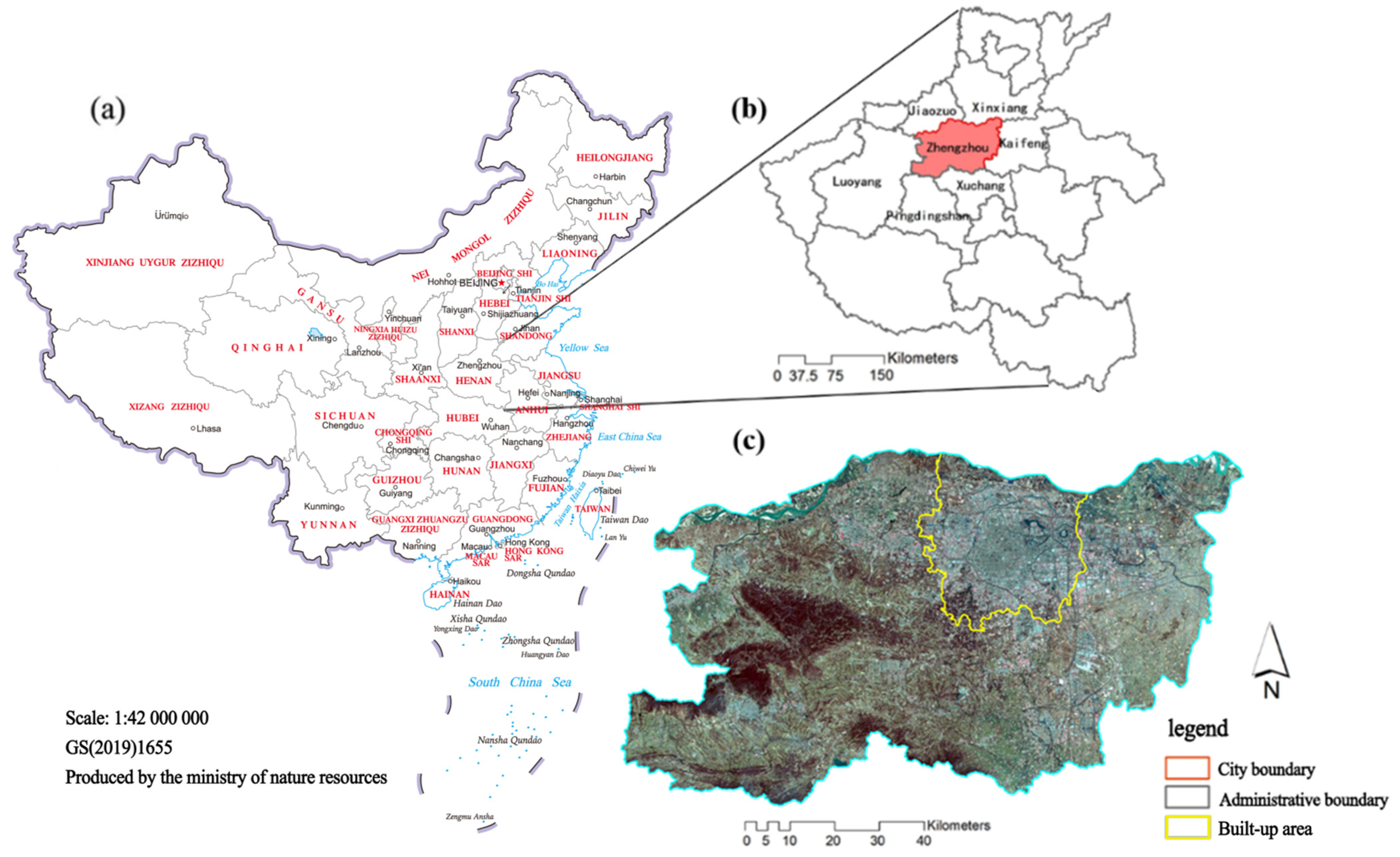
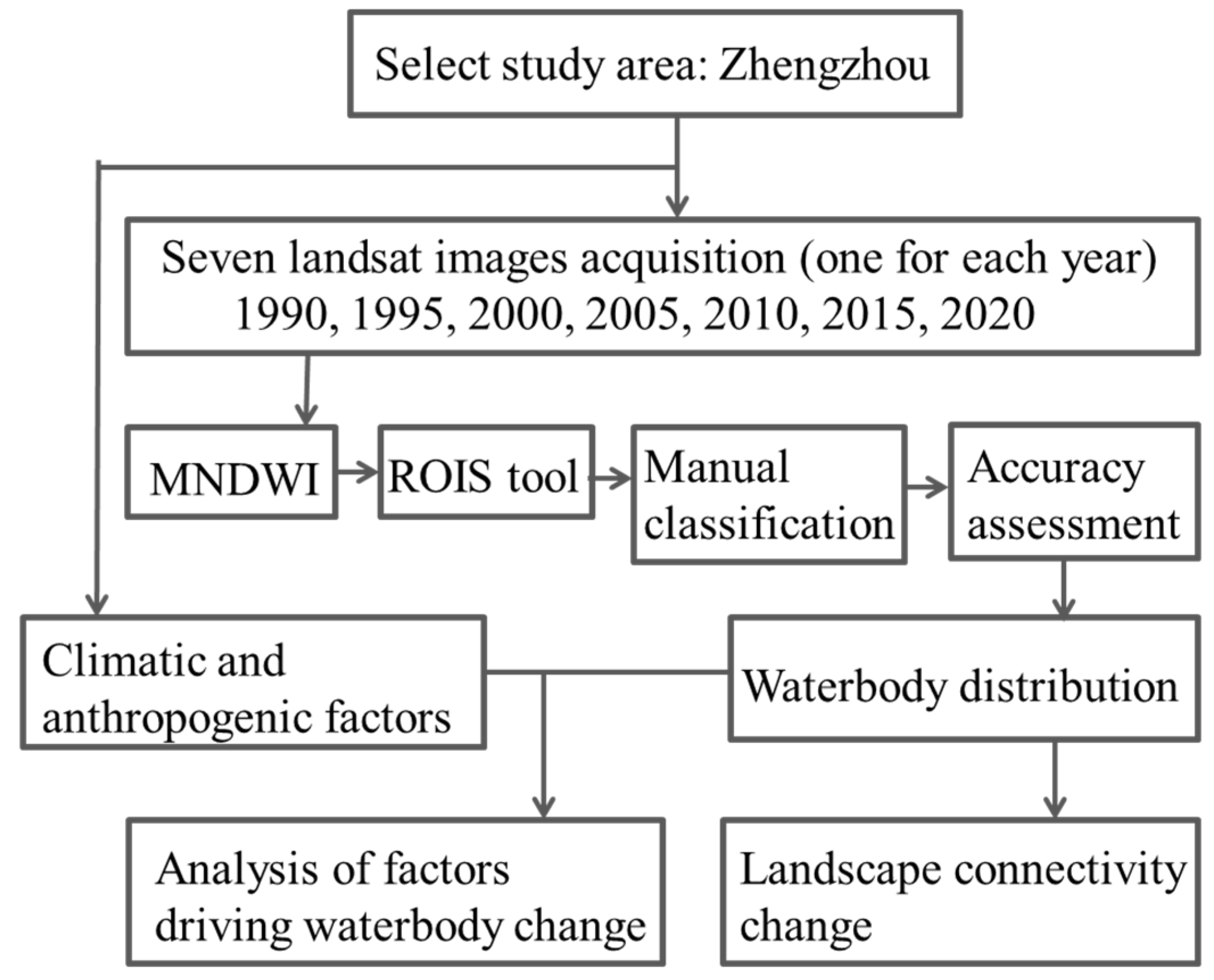

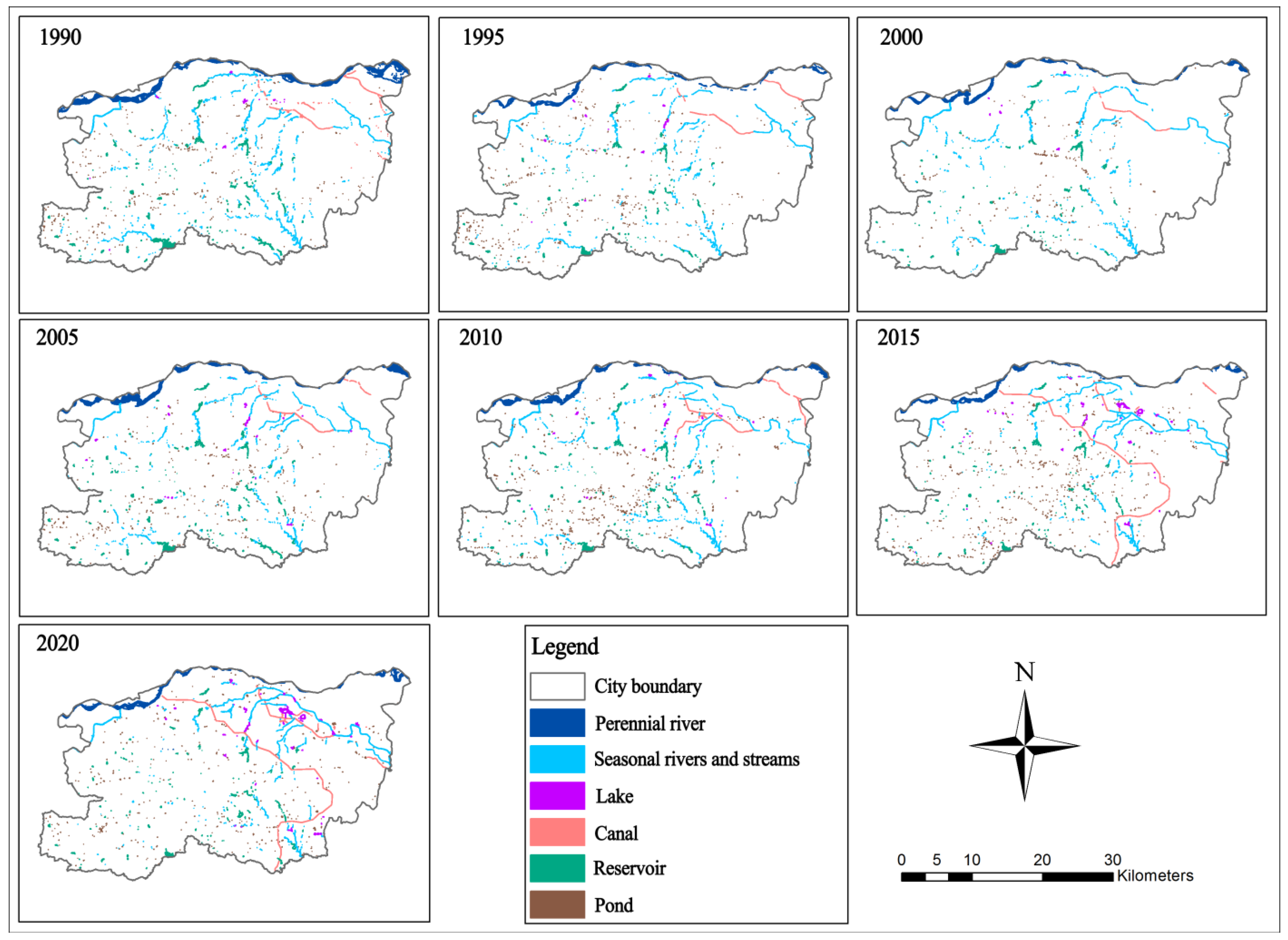
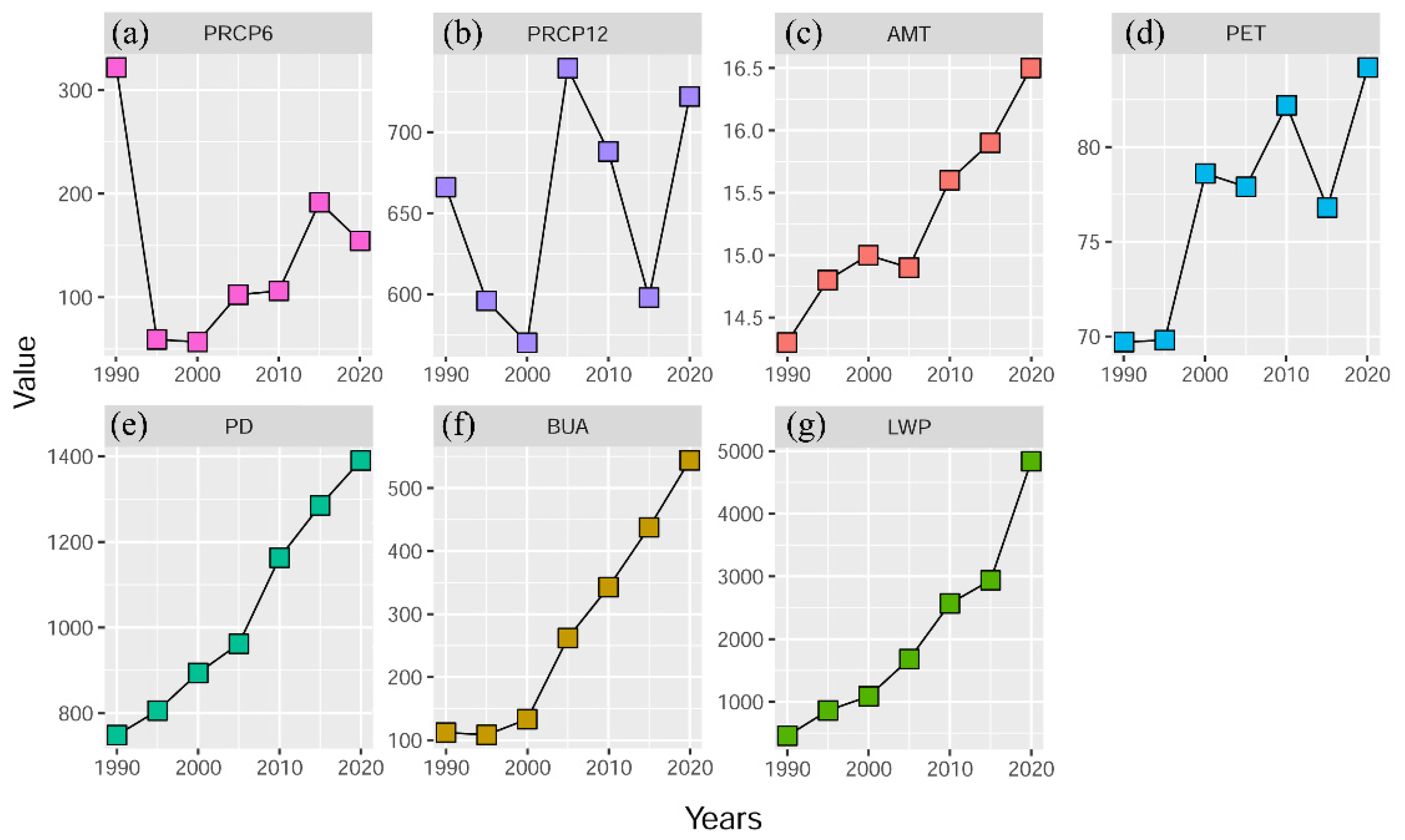
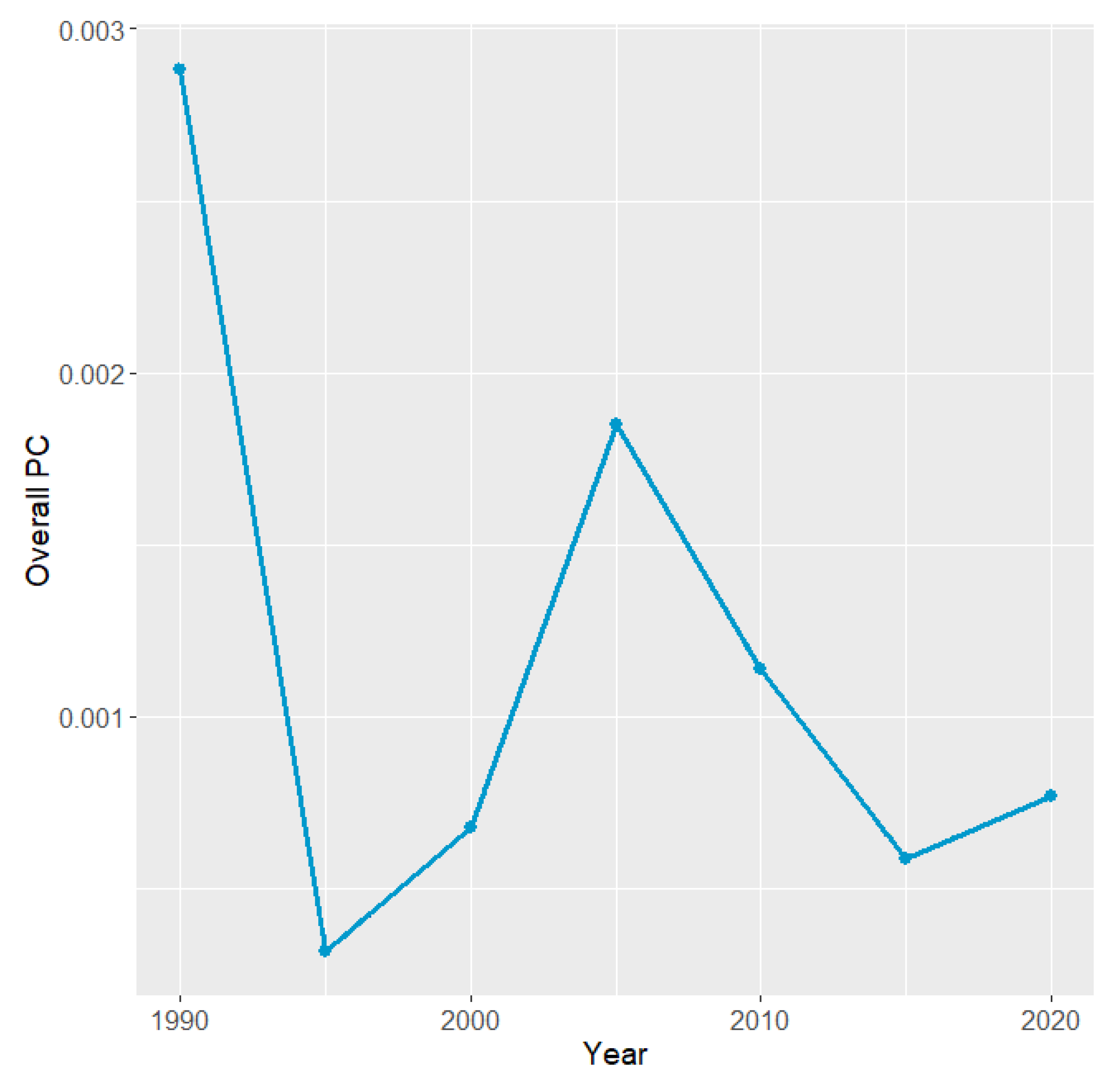
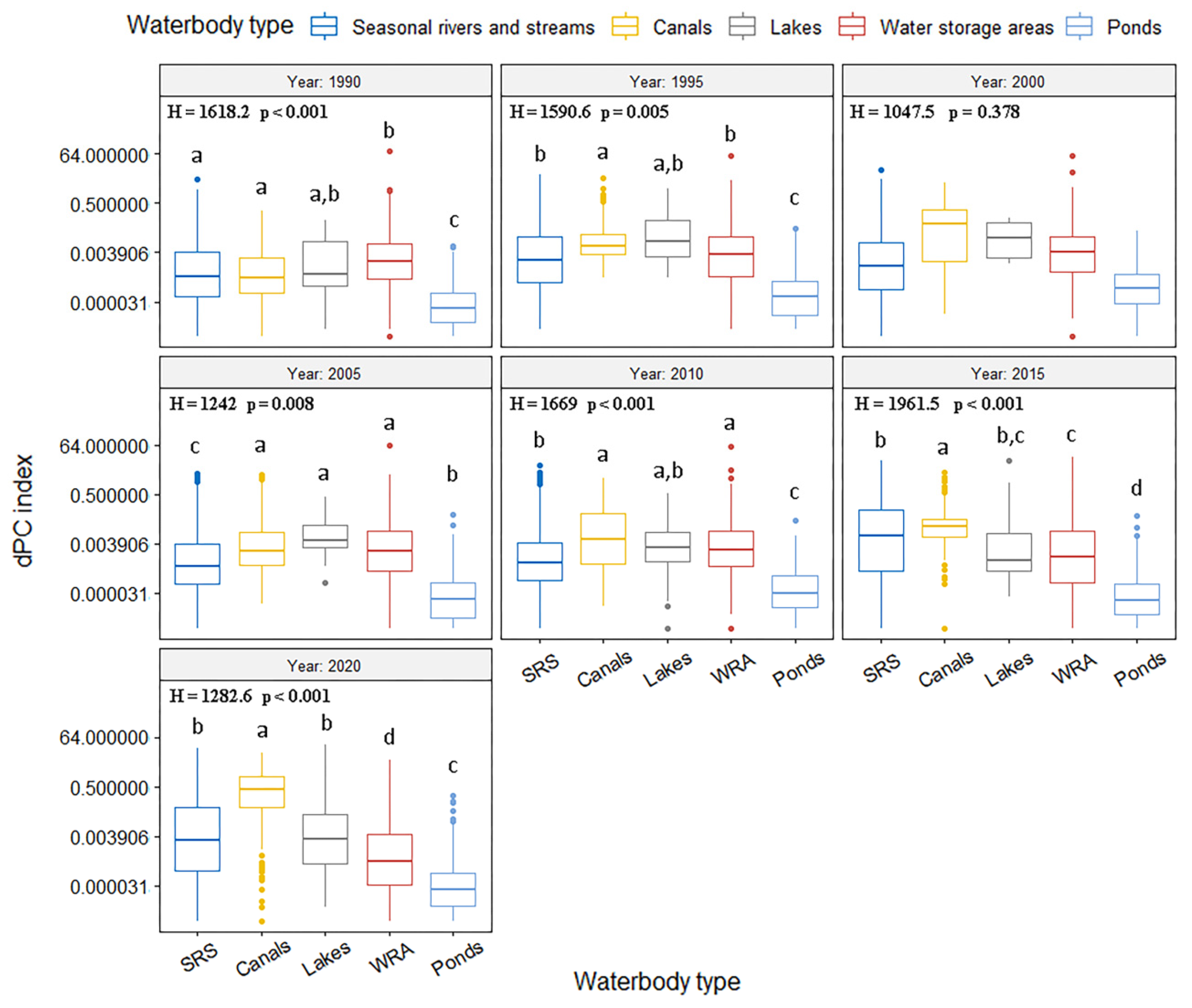
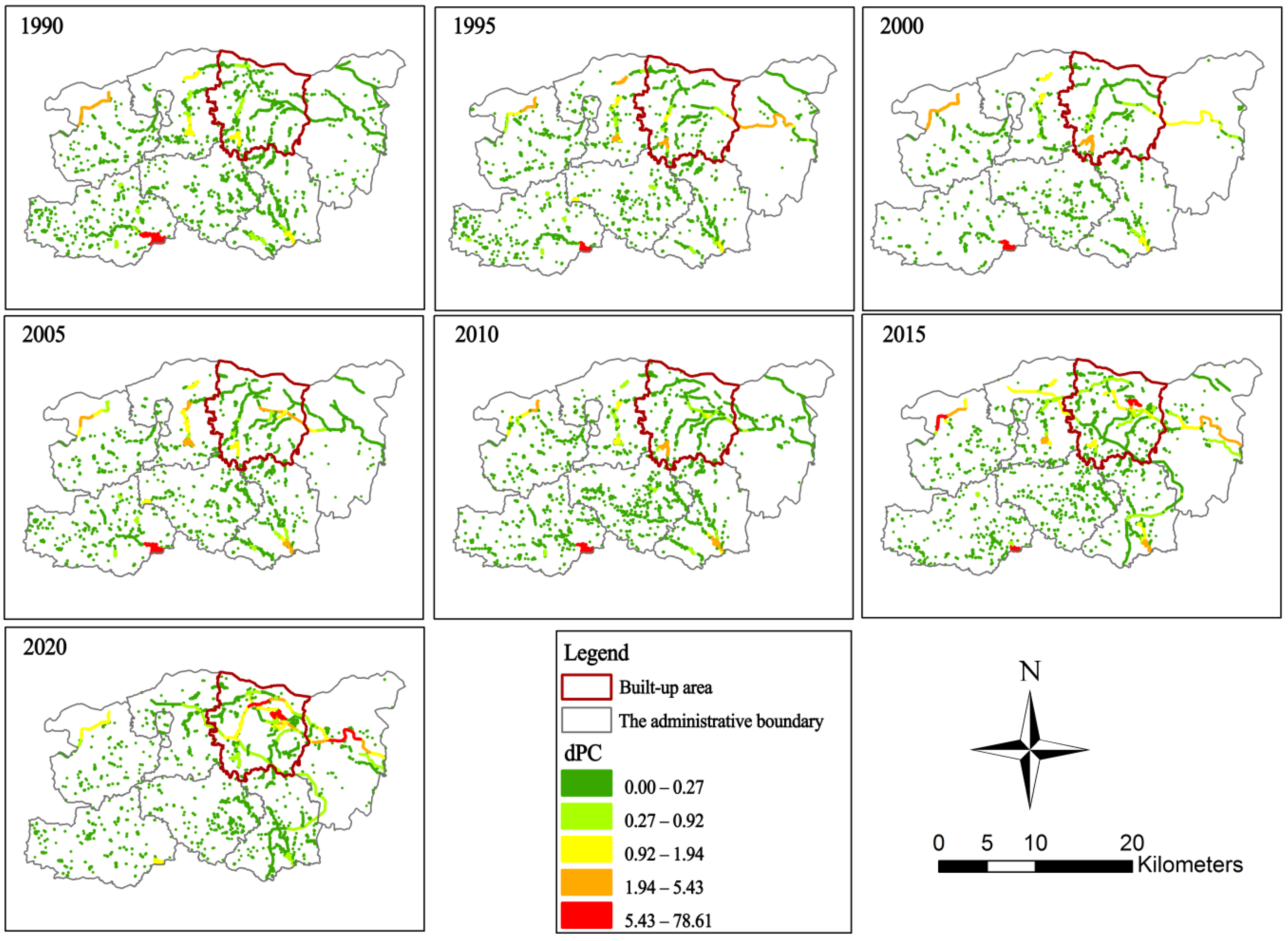
| Waterbody Type | Preview | Description |
|---|---|---|
| Perennial river |  | A stream or river (channel) that has continuous flow in parts of its stream bed throughout the year during years of normal rainfall. In this paper, the perennial river refers specifically to the Yellow River. |
| Seasonal rivers and streams | 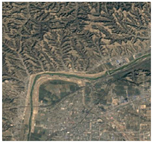 | Seasonal rivers and streams are particularly affected by seasonality and partially dry up during the dry season due to insufficient recharge. |
| Lakes |  | Permanent freshwater lakes; seasonal/intermittent freshwater lakes (>8 ha *). Could include natural or constructed waterbodies. |
| Canals | 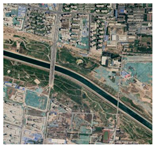 | Constructed canals and drainage channels. |
| Reservoirs | 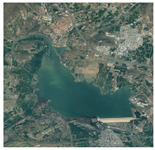 | Constructed water storage areas and impoundments (generally > 8 ha *). |
| Ponds | 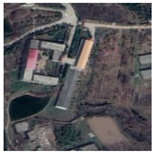 | Comparatively small constructed or natural shallow waterbodies (lentic ecosystems) including irrigation ponds, stock ponds, and small water tanks (generally < 8 ha *). |
| Year | BUA | LWP | PD | PET | PRCP6 | PRCP12 | AMT | |
|---|---|---|---|---|---|---|---|---|
| Year | 0.0003 | 0.0009 | <0.0001 | 0.0171 | 0.7383 | 0.4633 | 0.0004 | |
| BUA | 0.9694 | 0.0002 | <0.0001 | 0.046 | 0.8932 | 0.3306 | 0.0012 | |
| LWP | 0.9538 | 0.9738 | 0.0004 | 0.0296 | 0.9376 | 0.3467 | 0.0002 | |
| PD | 0.9862 | 0.9838 | 0.9656 | 0.0305 | 0.934 | 0.5092 | 0.0001 | |
| PET | 0.8435 | 0.7631 | 0.803 | 0.8007 | 0.4852 | 0.3428 | 0.031 | |
| PRCP6 | −0.156 | 0.0631 | −0.0368 | −0.0389 | −0.3193 | 0.6625 | 0.7472 | |
| PRCP12 | 0.3345 | 0.434 | 0.4211 | 0.3028 | 0.4243 | 0.203 | 0.6363 | |
| AMT | 0.965 | 0.9464 | 0.9722 | 0.9778 | 0.7993 | −0.1506 | 0.2195 |
| Year | Overall Accuracy | Kappa Coefficients |
|---|---|---|
| 1990 | 93% | 0.91 |
| 1995 | 92% | 0.89 |
| 2000 | 93% | 0.90 |
| 2005 | 95% | 0.93 |
| 2010 | 87% | 0.83 |
| 2015 | 89% | 0.84 |
| 2020 | 96% | 0.94 |
| dPC Index | Waterbody Type | 1990 | 1995 | 2000 | 2005 | 2010 | 2015 | 2020 |
|---|---|---|---|---|---|---|---|---|
| dPCintra | Seasonal rivers and streams | 43 | 45 | 42 | 39 | 36 | 47 | 29 |
| Canals | 7 | 6 | 8 | 7 | 12 | 13 | 26 | |
| Lakes | 3 | 7 | 5 | 9 | 12 | 13 | 20 | |
| Reservoirs | 46 | 37 | 40 | 45 | 40 | 27 | 25 | |
| Ponds | 1 | 5 | 5 | 0 | 0 | 0 | 0 | |
| dPCconnector | Seasonal rivers and streams | 85 | 82 | 79 | 72 | 53 | 65 | 35 |
| Canals | 9 | 13 | 20 | 16 | 37 | 29 | 57 | |
| Lakes | 0 | 0 | 0 | 3 | 0 | 1 | 8 | |
| Reservoirs | 6 | 5 | 1 | 9 | 10 | 5 | 0 | |
| Ponds | 0 | 0 | 0 | 0 | 0 | 0 | 0 | |
| dPCflux | Seasonal rivers and streams | 66 | 71 | 71 | 58 | 51 | 63 | 40 |
| Canals | 11 | 13 | 11 | 13 | 27 | 15 | 41 | |
| Lakes | 2 | 2 | 2 | 3 | 5 | 11 | 15 | |
| Reservoirs | 21 | 14 | 16 | 26 | 17 | 11 | 4 | |
| Ponds | 0 | 0 | 0 | 0 | 0 | 0 | 0 |
Publisher’s Note: MDPI stays neutral with regard to jurisdictional claims in published maps and institutional affiliations. |
© 2021 by the authors. Licensee MDPI, Basel, Switzerland. This article is an open access article distributed under the terms and conditions of the Creative Commons Attribution (CC BY) license (https://creativecommons.org/licenses/by/4.0/).
Share and Cite
Liu, C.; Minor, E.S.; Garfinkel, M.B.; Mu, B.; Tian, G. Anthropogenic and Climatic Factors Differentially Affect Waterbody Area and Connectivity in an Urbanizing Landscape: A Case Study in Zhengzhou, China. Land 2021, 10, 1070. https://doi.org/10.3390/land10101070
Liu C, Minor ES, Garfinkel MB, Mu B, Tian G. Anthropogenic and Climatic Factors Differentially Affect Waterbody Area and Connectivity in an Urbanizing Landscape: A Case Study in Zhengzhou, China. Land. 2021; 10(10):1070. https://doi.org/10.3390/land10101070
Chicago/Turabian StyleLiu, Chang, Emily S. Minor, Megan B. Garfinkel, Bo Mu, and Guohang Tian. 2021. "Anthropogenic and Climatic Factors Differentially Affect Waterbody Area and Connectivity in an Urbanizing Landscape: A Case Study in Zhengzhou, China" Land 10, no. 10: 1070. https://doi.org/10.3390/land10101070
APA StyleLiu, C., Minor, E. S., Garfinkel, M. B., Mu, B., & Tian, G. (2021). Anthropogenic and Climatic Factors Differentially Affect Waterbody Area and Connectivity in an Urbanizing Landscape: A Case Study in Zhengzhou, China. Land, 10(10), 1070. https://doi.org/10.3390/land10101070








